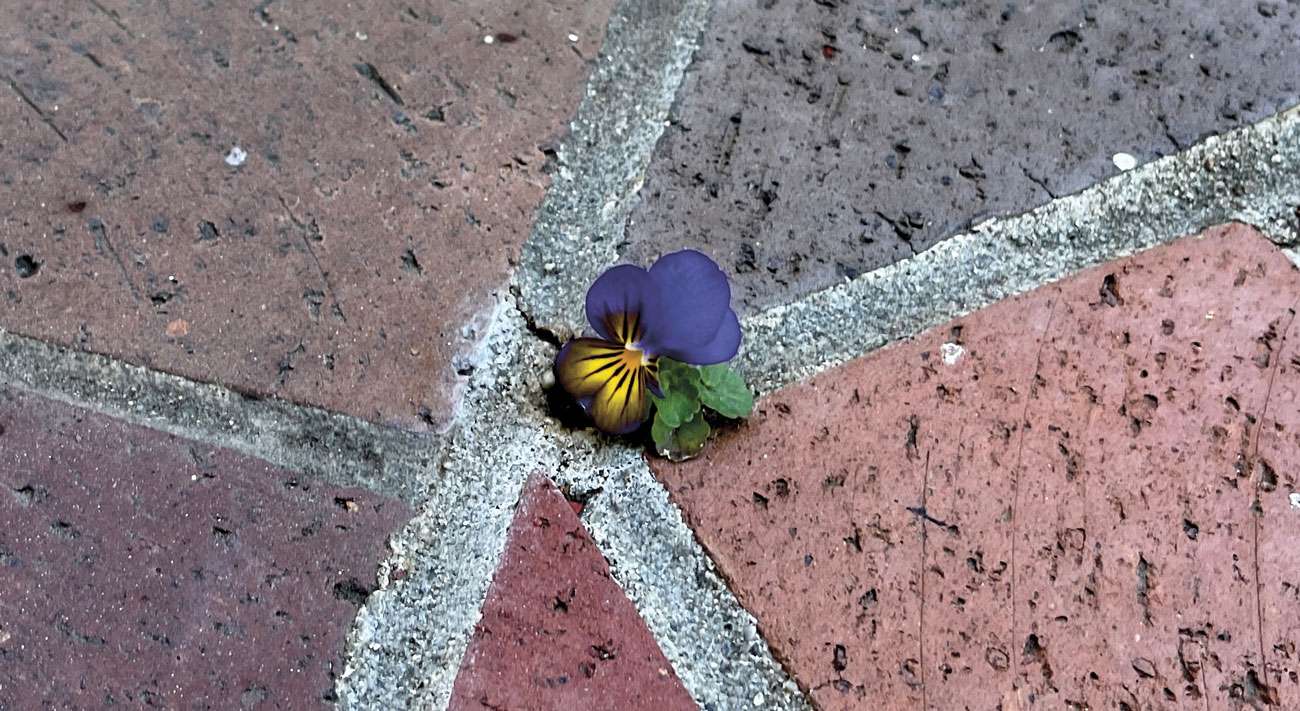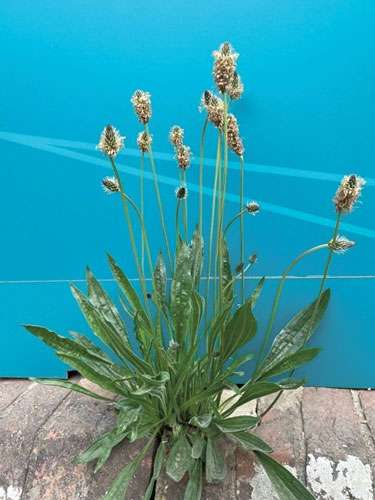
Photo © Holly Finn
The photo of the pansy in the paving was sent to me by a friend – and she gave the picture the title ‘Persistence’. It is greatly cheering to see that Nature finds chinks and niches to colonise, and then flourishes.
Everywhere you look at this time of the year there are wild flowers establishing themselves in unlikely places; gutters, verges, holes in masonry. Like the plantain which had tucked itself into a crack in the wall below the hoarding advertising a new development in Cranleigh by a company calling itself Renaissance. Perhaps the plantain saw that as encouragement?
There are two common types of plantain. The botanical name Plantago comes from the Latin planta meaning ‘sole of a foot’ which describes the shape of the broader-leaved species. Hoary plantain and plantain major belong to this group and they are unusual in that the flowers produce a delicate scent to attract insects for pollination. The flowers produce many seeds which are attractive to birds and are often found in bird seed mixtures. One of its common names is ‘birds’ meat’ – for obvious reasons.
The plaintain I spotted was Plantago lanceolata, and as you can see from the photo Andy Bamford took, the leaves are spear- shaped, hence its name. It is also known as ribwort and became common in the British Isles at about the time the Stone Age farmers were clearing the tree cover and establishing settlements – about 5,000 years ago. Analysis of pollen preserved in peat bogs and lakes is evidence of how widespread this plant became. The ribwort sprouts from the protected base of the plant, which is a great survival mechanism, allowing it to regrow if nibbled by cows or mown by gardeners in the lawn. It forms upright rosettes, with the flower-heads raised well above the leaves. This form of plantain is wind pollinated and has no scent.
A couple of days after the photo was taken, the developers took down the hoarding and away went the lovely plantain and its opportunistic friends; the ivy and the sow-thistle. They will be back.
Photo © Andy Bamford
Earthworms are credited with extraordinary powers of regeneration. Perhaps as a child you were told that if you chop a worm in half it will turn into two fully functioning worms. Maybe this fiction was invented to protect children’s sensibilities as a lot of worms get chopped up in the garden. Unfortunately, it is not true. The worm only has one mouth – so that half might survive and regenerate a tail, but the other half will starve to death. If the spade goes through the clitella or the ‘saddle’ of the worm, this is where the vital organs are and the worm will not survive at all.
They are surprising creatures which if they avoid the birds and the spade, live for up to 10 years. They eat their own weight in soil and plant detritus every day and are of inestimable value to the gardener and the farmer in improving the soil. During the bonanza years for the agrochemical companies in the 1960s and 70s, farmers were encouraged to heavily overuse pesticides – insecticides being particularly harmful to earthworms.
The word ‘worm’ is interesting – and in ancient times it could be used to describe all kinds of slinking, sliding creatures up to the size of dragons. If prefixed with the word ‘miserable’ it becomes an insult.
I remember the history class tittering at the mention of ‘The Diet of Worms’ – Luther’s defence of his doctrines in the presence of Charles V, in the German city of Worms. Bugs such as silverfish, book lice and linoleum beetles are known as ‘bookworms’ and that’s probably the origin of the name ‘bookworm’ for a person who loves reading and always has their nose in a book.
On June 2nd between 11.00am and 2,00pm we are holding an Open Day at Beryl Harvey Fields, Cranleigh’s Conservation site, off Knowle Lane. There will be plenty to see and do for everyone. Come and join us!
Beryl Harvey Fields is Cranleigh’s nature conservation site. We need volunteers. For further information: visit our conservation site in Cranleigh – or better, volunteer. Contact Philip Townsend at: townsendp99@gmail.com for details.












